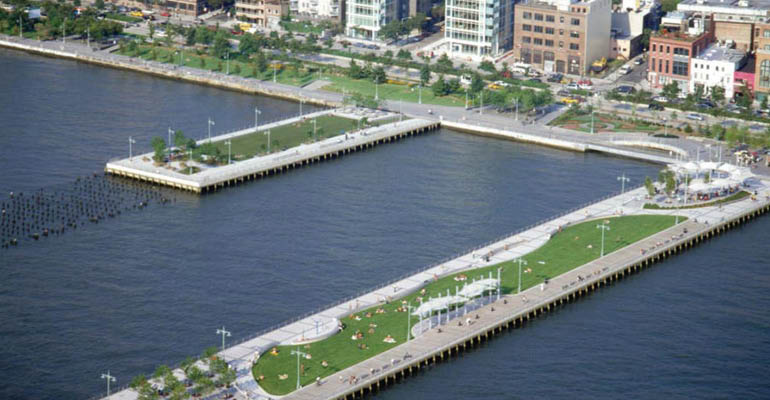The program now processes compost at seven drop-off sites, seven days a week.

What started as a small composting program intended for park staff at New York City’s Hudson River Park has now blossomed into a program that serves an entire neighborhood in Manhattan. The program is helping the city fill a gap in services as it works to make curbside organics recycling available to all residents by the end of 2018.
The program now processes compost at seven drop-off sites, seven days a week. In June, when this offering opened to the community, residents dropped off 3,000 pounds of food scraps in brown bins provided by the Department of Sanitation (DSNY).
In 2016, the compost program diverted more than 350,000 pounds of organic waste. This year, through its community program, it hopes to grow that volume by another 100,000 pounds.
“Parks provide a unique opportunity for compost because we have the space and in return [composting] supports the health of our parkland,” says Carrie Roble, director of environmental education and stewardship for the Hudson River Park. The organics are converted into nutrient-rich compost to protect and nourish plants and plant beds.
Hudson River Park’s earliest efforts were to collect its own horticultural waste. Then it started a small compost club, providing employees a drop-off site for food scraps and training them to compost.
“Instead of us trucking waste out, we can keep it in the park boundaries,” Roble says. “So we are not spending or burning fossil fuels to transport the waste to be processed.”
A staff horticultural team leads in processing the compost and has been troubleshooting ways to efficiently reach the greatest capacity. A staff operations team leads in collection and moving scraps to compost. Roble represents the environmental and education team, which trains and supports volunteers.
Volunteers are paired with horticultural experts who support them as they help with shredding compost or moving piles to be cured. Others contribute as ambassadors, doing education and outreach on compost.
“Working with partners across the city, including the people behind Hudson River Park, brings additional organics recycling opportunities to more and more city residents,” says Debbie Sheintoch, deputy director, Bureau of Recycling and Sustainability, DSNY. “Working directly with residents is important … the volunteers help to demonstrate what compost is and how it can be used. They help residents understand how their “trash” is really a valuable asset.”
Park volunteer Zazel Loven takes on roles from passing out flyers to knocking on residents’ doors and asking them to bring in their food scraps to stopping in on building supervisors and pitching the concept of starting collection sites on their properties.
A long-time composter who spent years pulling her neighbors into compost initiatives, Loven says she learned that education and outreach are essential to growing programs. It’s why local schools are among her stops as she spreads the word.
“If we can get children interested in composting we can educate parents. So to me it’s a way in to get families to take composting as a serious responsibility, and for it to become a part of their routine,” says Loven.
Bringing change among the city’s large population of apartment dwellers has been hard. There are storage space issues, and a lot of building managers are skeptical.
“Many supers say I could never get people to do this, and it’s extra work for staff. So it’s going back again and again,” says Loven. And this is what she is doing.
“Chelsea [the community where Loven lives] has two housing complexes, and if we could get them to have drop-off sites that would be one huge step. I am working on that,” she says.
For now, she is picking up food scraps from residents’ homes if they prefer, but the end goal is to get them to actively participate and realize it’s good for the community.
“When people hear what a difference it makes, they get it,” says Loven.
As important as the message, is the messenger—the volunteers.
“Our community members are champions, and they are telling their neighbors, this is easy. They tell them how it impacts the health of the place where they live,” says Roble.
When it’s from them, it resonates, she says.
“So we encourage our volunteers to speak from their experience and to talk of “our park,” “our city,” and “our environment.”
About the Author(s)
You May Also Like




